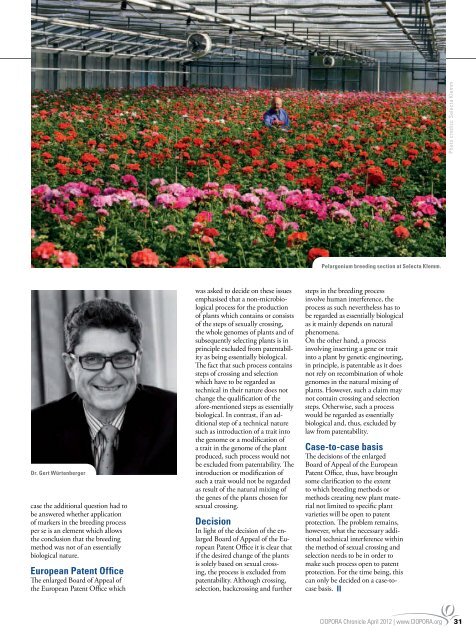2012 CIOPORA Chronicle
CIOPORA annual magazine on Intellectual Property protection for plant innovations 2012. The magazine was produced in cooperation with FloraCulture International. Read in the 2012 CIOPORA Chronicle edition: - Plant Patents in the United States after the America Invents Act - U.S. plant patents compared to UPOV PBR system - Does Belgian patent law need a breeder’s exemption? - How much open access can breeders afford? - IPP and PBR in Chile - IP protection for plant innovations in Canada and much more...
CIOPORA annual magazine on Intellectual Property protection for plant innovations 2012. The magazine was produced in cooperation with FloraCulture International.
Read in the 2012 CIOPORA Chronicle edition:
- Plant Patents in the United States after the America Invents Act
- U.S. plant patents compared to UPOV PBR system
- Does Belgian patent law need a breeder’s exemption?
- How much open access can breeders afford?
- IPP and PBR in Chile
- IP protection for plant innovations in Canada
and much more...
You also want an ePaper? Increase the reach of your titles
YUMPU automatically turns print PDFs into web optimized ePapers that Google loves.
Photo credits: Selecta Klemm<br />
Pelargonium breeding section at Selecta Klemm.<br />
Dr. Gert Würtenberger<br />
case the additional question had to<br />
be answered whether application<br />
of markers in the breeding process<br />
per se is an element which allows<br />
the conclusion that the breeding<br />
method was not of an essentially<br />
biological nature.<br />
European Patent Office<br />
The enlarged Board of Appeal of<br />
the European Patent Office which<br />
was asked to decide on these issues<br />
emphasised that a non-microbiological<br />
process for the production<br />
of plants which contains or consists<br />
of the steps of sexually crossing,<br />
the whole genomes of plants and of<br />
subsequently selecting plants is in<br />
principle excluded from patentability<br />
as being essentially biological.<br />
The fact that such process contains<br />
steps of crossing and selection<br />
which have to be regarded as<br />
technical in their nature does not<br />
change the qualification of the<br />
afore-mentioned steps as essentially<br />
biological. In contrast, if an additional<br />
step of a technical nature<br />
such as introduction of a trait into<br />
the genome or a modification of<br />
a trait in the genome of the plant<br />
produced, such process would not<br />
be excluded from patentability. The<br />
introduction or modification of<br />
such a trait would not be regarded<br />
as result of the natural mixing of<br />
the genes of the plants chosen for<br />
sexual crossing.<br />
Decision<br />
In light of the decision of the enlarged<br />
Board of Appeal of the European<br />
Patent Office it is clear that<br />
if the desired change of the plants<br />
is solely based on sexual crossing,<br />
the process is excluded from<br />
patentability. Although crossing,<br />
selection, backcrossing and further<br />
steps in the breeding process<br />
involve human interference, the<br />
process as such nevertheless has to<br />
be regarded as essentially biological<br />
as it mainly depends on natural<br />
phenomena.<br />
On the other hand, a process<br />
involving inserting a gene or trait<br />
into a plant by genetic engineering,<br />
in principle, is patentable as it does<br />
not rely on recombination of whole<br />
genomes in the natural mixing of<br />
plants. However, such a claim may<br />
not contain crossing and selection<br />
steps. Otherwise, such a process<br />
would be regarded as essentially<br />
biological and, thus, excluded by<br />
law from patentability.<br />
Case-to-case basis<br />
The decisions of the enlarged<br />
Board of Appeal of the European<br />
Patent Office, thus, have brought<br />
some clarification to the extent<br />
to which breeding methods or<br />
methods creating new plant material<br />
not limited to specific plant<br />
varieties will be open to patent<br />
protection. The problem remains,<br />
however, what the necessary additional<br />
technical interference within<br />
the method of sexual crossing and<br />
selection needs to be in order to<br />
make such process open to patent<br />
protection. For the time being, this<br />
can only be decided on a case-tocase<br />
basis. |||<br />
<strong>CIOPORA</strong> <strong>Chronicle</strong> April <strong>2012</strong> | www.<strong>CIOPORA</strong>.org 31









